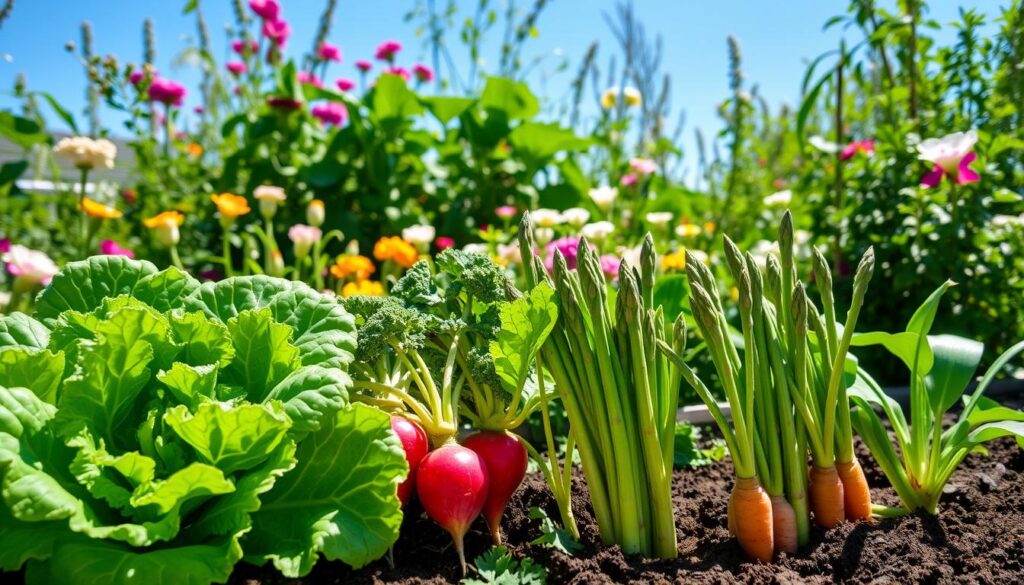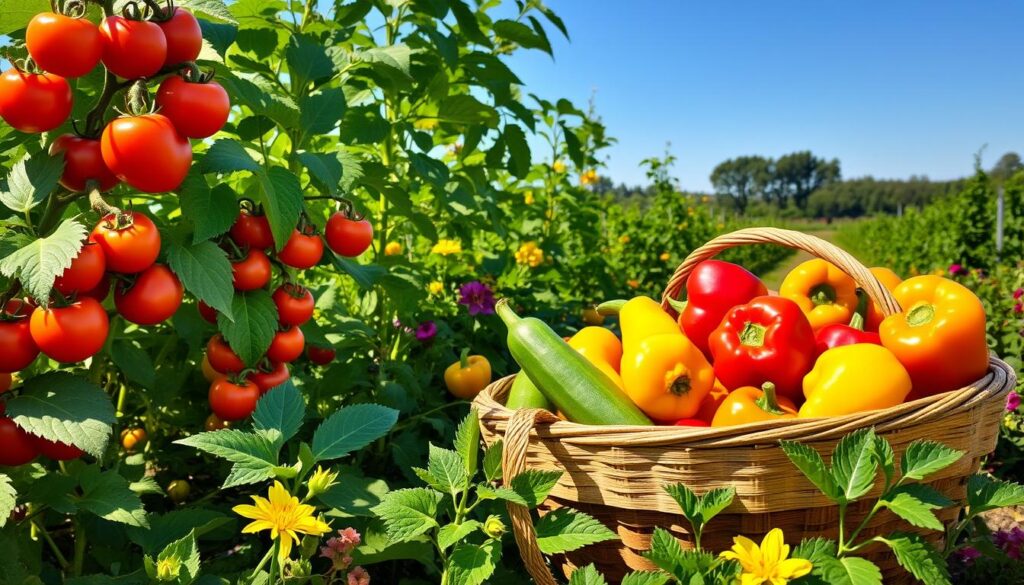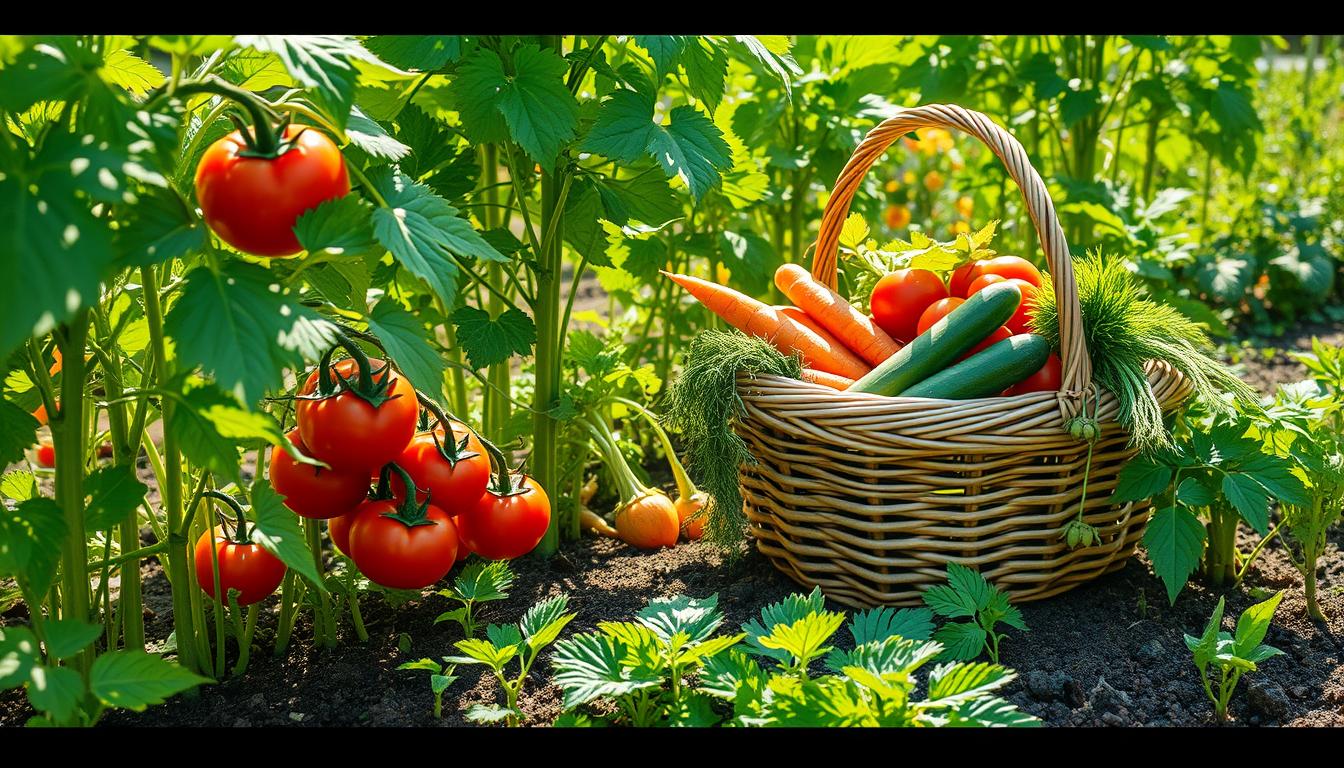As a passionate gardener, I know how crucial it is to harvest vegetables at the right time. The timing can greatly affect their taste, texture, and quality. That’s why I’ve put together this detailed guide to help you harvest your garden’s vegetables month by month.
In this article, I’ll share the essential tips for harvesting on time. I’ll also cover the vegetables you can pick each month. Whether you’re an experienced gardener or just starting, this guide will help you get the most out of your garden. You’ll enjoy the freshest, tastiest flavors with your family.
Key Takeaways
- Discover the importance of timely vegetable harvesting for maximum flavor and yield.
- Learn the key factors that influence harvest time, such as maturity, weather, and plant variety.
- Explore a month-by-month guide to harvesting a wide range of vegetables throughout the growing season.
- Gain valuable insights to help you maximize the bounty of your home garden.
- Become a more confident and successful vegetable gardener by mastering the art of proper harvesting.
Introduction to Harvesting Vegetables
Knowing the vegetable harvesting basics is key to getting the most flavor and nutrition from your garden. The right time to harvest is very important. Different things can affect when the best time is. Learning about these factors impacting harvest time helps you get the most from your garden.
Importance of Timely Harvesting
Harvesting vegetables at the right time is very important. It makes sure they are at their best taste and texture. It also keeps more nutrients in them, as they can lose some over time.
Harvesting quickly also helps avoid waste. This way, you can enjoy your fresh, homegrown food.
Factors Affecting Harvest Time
- Plant Maturity: Each vegetable variety has an optimal maturity stage for harvesting, which can be determined by factors such as size, color, and texture.
- Weather Conditions: Extreme temperatures, rainfall, and other environmental factors can impact the ideal harvest window, necessitating close monitoring of your garden’s conditions.
- Storage Needs: Considering how you plan to store the harvested vegetables can also influence when you should collect them, as some crops may have different storage requirements.
By understanding the vegetable harvesting basics, the importance of timely harvest, and the various factors impacting harvest time, you can ensure your garden’s bounty is enjoyed at its absolute best.
When to Harvest Vegetables: A Month-by-Month Guide
To get the most from your garden, knowing when to pick each vegetable is crucial. This guide helps you harvest at the perfect time. This way, you can enjoy the tastiest, freshest produce all year.
This monthly vegetable harvesting guide covers cool-weather crops like leafy greens and root veggies. It also includes warm-weather favorites like tomatoes and peppers. It’s your go-to for the best times to pick a variety of vegetable harvest calendar crops.
Harvesting Vegetables by Month
Keeping up with your harvest schedule is vital for a steady supply of fresh veggies. Here’s a month-by-month guide for popular vegetables:
- January: Greens, carrots, parsnips, Brussels sprouts
- February: Broccoli, cauliflower, kale, turnips
- March: Peas, radishes, spinach, lettuce
- April: Asparagus, green onions, arugula, beets
- May: Snap peas, zucchini, cucumbers, green beans
- June: Tomatoes, peppers, eggplant, summer squash
- July: Corn, melons, okra, pole beans
- August: Potatoes, onions, carrots, beets
- September: Broccoli, cauliflower, kale, Brussels sprouts
- October: Pumpkins, winter squash, leeks, parsnips
- November: Greens, carrots, turnips, rutabagas
- December: Cabbage, Brussels sprouts, kale, parsnips
By following this guide, you can have a steady flow of fresh, tasty veggies all year. It’s your key to success with your monthly vegetable harvesting guide and seasonal vegetable harvest calendar.
“Proper timing of your vegetable harvests is essential for maximizing both quality and quantity. This monthly guide takes the guesswork out of when to harvest for the best results.”
January Harvest
Winter is here, but gardeners can still find plenty to harvest in January. The selection might be smaller than in warmer months. But with the right strategy, you can enjoy a rich harvest.
Vegetables to Harvest in January
In colder areas, January’s harvest focuses on hardy, cold-resistant crops. These can handle the cold well. Here are some top picks for January:
- Leafy greens such as kale, spinach, and Swiss chard
- Root vegetables like carrots, parsnips, and beets
- Brassicas like Brussels sprouts, cabbage, and broccoli
These veggies are bred for the cold. They’re perfect for a January harvest. With the right care, you can get fresh, healthy food right through winter.
| Vegetable | Ideal Harvesting Conditions | Preparation Tips |
|---|---|---|
| Kale | Tolerates frost and light freezing temperatures | Trim leaves from the bottom up, leaving the core intact for continued growth |
| Carrots | Can be left in the ground and harvested as needed throughout winter | Gently loosen soil around the carrots and pull them up by the greens |
| Brussels Sprouts | Sweetens in flavor after exposure to frost | Harvest sprouts from the bottom of the stalk, leaving the top buds to continue growing |
By using winter’s harvest, you can enjoy a wide range of fresh, tasty foods. A little planning and care can make January’s harvest a season highlight.
February Harvest
February marks the start of spring, bringing a chance to harvest many vegetables. Even though it’s still cold, gardeners can enjoy February’s vegetable harvest. They can see the results of their hard work.
Hardy cabbage is a top pick for late winter vegetable harvesting. It can handle the cold and adds nutrition to many dishes. Kale, collards, and Brussels sprouts are also great choices. They provide a lot of food for those who watch their gardens closely.
- Cabbage
- Kale
- Collards
- Brussels sprouts
February also brings early spring vegetables. Carrots, parsnips, and radishes are ready to be picked. They add a fresh taste to salads and other dishes. Their crisp flavor hints at the warmer days ahead.
“Embracing the February harvest shows the strength and flexibility of the vegetable garden. With some planning, gardeners can enjoy a rich harvest even in winter.”
By using February’s harvest, gardeners can make their growing season longer. They can enjoy the start of spring with a little creativity. The February harvest is a treat for the senses and taste buds.
March Harvest
Spring is coming, and gardeners can’t wait to pick fresh veggies. March is a time when cool-weather crops from fall start to grow. It’s also when the first spring veggies appear. Let’s explore the March harvest and the veggies you can expect.
Spring Veggies to Harvest
The March harvest celebrates the changing seasons. Asparagus is a standout, signaling spring’s arrival. It’s ready when the soil warms up. Radish also starts to grow in March’s cool, moist weather.
Leafy greens like spinach, kale, and arugula are ready in March. They’re great in salads or sautéed. Peas also start to grow, offering sweet, crunchy pods as the weather gets warmer.
Overwintering Crop Harvesting
March isn’t just for new veggies; it’s also for overwintering crops. Carrots, parsnips, and turnips planted in fall are now ready. These crops have been waiting and have richer flavors from the cold.
When planning your March harvest, think about both new and overwintering crops. This mix of fresh, seasonal produce will make your spring harvest amazing.

April Harvest
As the weather warms up, April brings a fresh wave of vegetables. From crisp greens to tender roots, it’s a great time to pick the season’s first treasures. Let’s explore the best times to harvest these spring crops and how to make your April garden flourish.
Harvesting Spring Greens and Lettuces
Leafy greens and lettuces are among the first to mature in spring. Spinach, arugula, and leaf lettuce are ready by April. They add freshness and nutrition to your meals. To keep them coming, just cut the outer leaves, letting the inner ones grow.
Unlocking the Potential of Root Vegetables
April is also the time for early root crops like radishes, turnips, and carrots. These veggies love the cool spring soil. They add a crisp flavor to salads and sides. Watch their growth and pick them when they’re 4-6 weeks old.
Embracing the Versatility of Brassicas
Broccoli, cauliflower, and cabbage are stars in the April garden. They’re packed with nutrients and can be picked when their heads are firm. Cut the heads carefully, leaving some stem, to keep them growing.
| Vegetable | Optimal Harvest Time | Harvesting Tips |
|---|---|---|
| Spinach | 4-6 weeks after planting | Cut outer leaves, allowing inner leaves to continue growing |
| Radishes | 3-4 weeks after planting | Harvest when roots are 1-2 inches in diameter |
| Broccoli | 6-8 weeks after planting | Cut heads when florets are tightly packed |
April’s garden is alive with the first vegetables of the season. Knowing when and how to harvest can make your April vegetable harvest even better. Enjoy the early spring vegetable harvesting to the fullest.
May Harvest
May brings longer days and warmer temperatures, making it a great time for vegetable growers. This is when you get to enjoy the fruits of your labor from late spring gardening. Let’s dive into the exciting crops ready for harvest in this lively month.
Asparagus is a standout in May. It’s a perennial that loves the mild spring weather. Harvest it when spears are 6-8 inches tall, before they open up.
Radishes are another favorite in May. They’re crunchy and peppery, perfect for salads and snacks. Watch them closely, as they can get too big and woody if not picked soon.
- Asparagus
- Radishes
- Lettuce
- Spinach
- Peas
- Carrots
- Beets
Lettuce and spinach are at their best in May. They’re full of nutrients and taste great. Harvest them in the morning for the best flavor.
Peas, both snow and snap, are a May highlight. They’re sweet and crunchy, perfect for eating fresh. Carrots and beets also do well in May’s mild weather, adding vibrant colors and flavors to your harvest.
The May vegetable harvest is a true celebration of the season’s bounty. By harvesting your late spring vegetable gardening at the right time, you’ll enjoy a variety of fresh, tasty produce from your garden.
June Harvest
June is a time of plenty for gardeners. The summer season is in full swing, bringing fresh, tasty vegetables. Whether you grow your own or buy from local farms, now is the time to enjoy your hard work. Let’s look at how to harvest summer veggies at their best.
Timing is Key for June Vegetable Harvest
Getting your June harvest right means watching your plants closely. Crops like zucchini, summer squash, green beans, and tomatoes are ready in early summer. Harvesting them at the right time is key for the best taste and texture.
- Zucchini and summer squash are best harvested when they are 6-8 inches long and have a firm, glossy skin.
- Green beans should be picked when the pods are smooth, plump, and snap easily when bent.
- Tomatoes are ripe for the picking when they have a deep, rich color and yield slightly when gently squeezed.
Watching for visual cues and texture will help you know when to pick. This ensures your veggies are fresh and full of flavor.
Gentle Handling for Optimal Quality
When you harvest your June veggies, handle them carefully. Avoid pulling hard on the plants to prevent damage. Instead, use clean, sharp tools to gently cut the veggies from the plant.
| Vegetable | Ideal Harvesting Time | Harvesting Technique |
|---|---|---|
| Zucchini | 6-8 inches long | Cut with sharp knife, leaving 1-2 inches of stem |
| Green Beans | Pods are smooth and plump | Snap or snip pods from plant |
| Tomatoes | Deep color and slight yield | Gently twist and pull from vine |
By using these gentle methods, you’ll keep your June harvest in top shape. Your veggies will be ready to make delicious summer dishes.
July Harvest
July brings a peak in summer heat, but it also brings a rich harvest of warm-weather vegetables. This is the best time to enjoy the fruits of your labor. You’ll find everything from juicy tomatoes to colorful peppers, all bursting with flavor and texture.
Harvesting Warm-Weather Vegetables
July is the perfect time to pick a variety of warm-weather vegetables. Each one has its own needs and the best way to harvest it. Knowing how to care for your crops is key to a successful harvest.
- Tomatoes: Look for fully ripe, deep-red tomatoes that yield slightly when gently squeezed. Carefully detach the fruit from the vine, taking care not to damage the plant.
- Peppers: Peppers are ready to harvest when they’ve reached the desired size and color. Snip the fruit from the plant, leaving a small stem attached.
- Eggplants: Harvest eggplants when they’re glossy, firm, and have a deep, rich color. Gently twist and pull the fruit from the plant.
- Zucchini and Summer Squash: Collect these warm-weather vegetables when they’re 6-8 inches long and tender. Slice or snap the fruit from the plant, leaving a short stem attached.
| Vegetable | Optimal Harvesting Time | Harvesting Technique |
|---|---|---|
| Tomatoes | When fully ripe and slightly yielding | Gently detach from the vine |
| Peppers | When they’ve reached desired size and color | Snip the fruit from the plant, leaving a short stem |
| Eggplants | When glossy, firm, and deep in color | Gently twist and pull the fruit from the plant |
| Zucchini and Summer Squash | When 6-8 inches long and tender | Slice or snap the fruit from the plant, leaving a short stem |
Learning how to harvest your July vegetables can make a big difference. It ensures your crops are at their best and gives you a fresh supply of delicious food.
August Harvest
August is a great time for gardeners as the summer heat peaks. You can harvest many late summer crops, like sun-ripened tomatoes and crisp cucumbers. The August vegetable harvest is a true celebration of the season’s abundance.
Tomatoes are a highlight in August. Whether you grow cherry, beefsteak, or heirloom tomatoes, August is the ideal time to pluck them from the vine at the peak of their flavor. Enjoy them in a summer salad with fresh basil and mozzarella, or use them in sauces and salsas for a burst of garden-fresh goodness.
- Cucumbers are another August garden staple, thriving in the warm, sunny conditions. Be sure to harvest them before they become overly large and bitter.
- Peppers, both sweet and spicy, also reach their prime during this late summer vegetable harvesting period.
- Additionally, keep an eye on your zucchini and summer squash plants, as they can quickly become oversized if not harvested regularly.
As the August vegetable harvest reaches its peak, it’s important to stay vigilant and monitor your crops closely. Regularly check for signs of pests or disease, and be prepared to take action to protect your hard-earned bounty.
| Vegetable | Ideal Harvesting Time | Tips |
|---|---|---|
| Tomatoes | When fully ripe, with a deep red color | Harvest in the morning for best flavor and texture |
| Cucumbers | When 6-8 inches long and firm | Avoid letting them become overly large and bitter |
| Peppers | When they reach their desired size and color | Check for pests and diseases regularly |
| Zucchini and Summer Squash | When 6-8 inches long and firm | Harvest frequently to encourage continued production |
By staying on top of your August vegetable harvest, you can enjoy a bountiful and flavorful late summer season. Savor the fresh, garden-grown goodness and let it inspire your culinary creativity!

September Harvest
September brings the perfect time to harvest fall vegetables. The cooler weather and shorter days are ideal. You can enjoy the freshest, tastiest produce from your garden.
Unlocking the Flavors of Fall
September is the best time for many vegetables. Root crops like carrots and beets are ready. Leafy greens and cool-weather crops like broccoli are also in season.
Harvesting at the right time is key. Here are some tips for a great September harvest:
- Root vegetables: Check their size and appearance. Harvest when they’re mature. Gently pull them up, leaving the greens.
- Leafy greens: Cut the outer leaves of kale and spinach. This lets the inner leaves grow. You’ll have fresh greens longer.
- Brassicas: Look for tight heads on broccoli and cauliflower. Harvest before the florets open. Pick Brussels sprouts as they mature.
Follow these tips for a delicious September harvest. Your garden will give you a bounty of seasonal treats.
October Harvest
October brings a mix of feelings to gardeners. The summer’s colors have faded, but the late season offers a chance to harvest cold-hardy veggies. It’s a time to enjoy the October harvest and get ready for winter.
Maximizing the Late Season Vegetable Harvest
Harvesting late season veggies needs care and attention. These crops have made it through tough times and are ready to give their last yield. Here are some tips for a successful harvest:
- Watch for signs like size, color, and texture to know when to pick.
- Keep your crops safe from frost by covering them or picking before it freezes.
- Handle the veggies gently to avoid damage, which can make them spoil faster.
- Store them in a cool, dry spot to keep them fresh longer.
Enjoying the unique tastes and toughness of late season veggies is rewarding for gardeners.
A Bountiful October Harvest
The October harvest brings a variety of cold-hardy crops. Each has its own taste and uses in the kitchen. Some top picks include:
- Brassicas (broccoli, cauliflower, Brussels sprouts)
- Root veggies (carrots, parsnips, rutabagas)
- Leafy greens (kale, Swiss chard, spinach)
- Alliums (onions, garlic, leeks)
These veggies add flavor, nutrients, and a final burst of life before winter.
“The true harvest of my daily life is somewhat as intangible and indescribable as the tints of morning or evening. It is a little star-dust caught, a segment of the rainbow I have clutched.” – Henry David Thoreau
As the harvest ends, gardeners can look back on the season. By embracing late season harvesting, they can enjoy the growing year longer and prepare for winter.
November Harvest
November marks the end of the gardening season, but it’s a time to enjoy the fruits of your labor. This month, you can harvest a variety of fall vegetables. Each one brings its own taste and health benefits. The November harvest shows how nature can thrive even in cooler weather.
Root vegetables like carrots, parsnips, and beets are at their best in November. They grow strong in the cooler air, giving them a deep, earthy taste. You can roast, sauté, or eat them raw in salads. They add a nice crunch and are full of vitamins and minerals.
Leafy greens like kale, Swiss chard, and spinach also do well in the fall. They’re a fresh and healthy addition to any meal. These greens are full of antioxidants, fiber, and vitamins, making them great for the colder months.
| Vegetable | Ideal Harvest Time | Culinary Uses |
|---|---|---|
| Carrots | Mid-to-late November | Roasting, sautéing, raw in salads |
| Beets | Late November | Roasting, pickling, juicing |
| Kale | Throughout November | Sautéing, making kale chips, adding to soups |
| Spinach | Early to mid-November | Salads, sautéing, adding to pasta dishes |
As the weather gets colder, the November harvest reminds us to enjoy the season’s offerings. By embracing the fall harvest, gardeners nourish their bodies and connect with nature’s cycles.
December Harvest
As the year ends, the December harvest brings a variety of winter-hardy vegetables. These crops grow well in cold weather, adding flavor and nutrition to our diets. The December vegetable harvest and winter vegetable harvesting are key to getting the most from our cold-weather gardens.
Harvesting Winter Greens
Winter greens like kale, spinach, and Swiss chard are top picks in December. They grow well in cold weather, making them a great choice for meals. To harvest, simply cut off the outer leaves, letting the plant keep growing.
Unearthing Root Vegetables
Root vegetables like carrots, parsnips, and beets are also great in December. They add a nice crunch and flavor to dishes. When you harvest, gently loosen the soil to protect the roots.
By focusing on the December vegetable harvest and winter vegetable harvesting, we can enjoy the season’s best. Our winter gardens can still give us plenty of fresh, nutritious vegetables, even as the year ends.
Conclusion
Timing is key when it comes to harvesting vegetables. It’s important for getting the best taste and quality from your garden. Knowing when to pick each type of vegetable helps you enjoy your harvest all year.
This guide has shown you how to harvest vegetables at the right time. It covers everything from spring to winter. By following these tips, your vegetables will be at their best.
Whether you’re new to gardening or have been doing it for years, this guide is for you. It helps you get the most out of your garden. With the right timing, you’ll have a constant supply of fresh, healthy vegetables all year.



Leave a Reply